Chantilly to Nanteuil-le-Haudouin
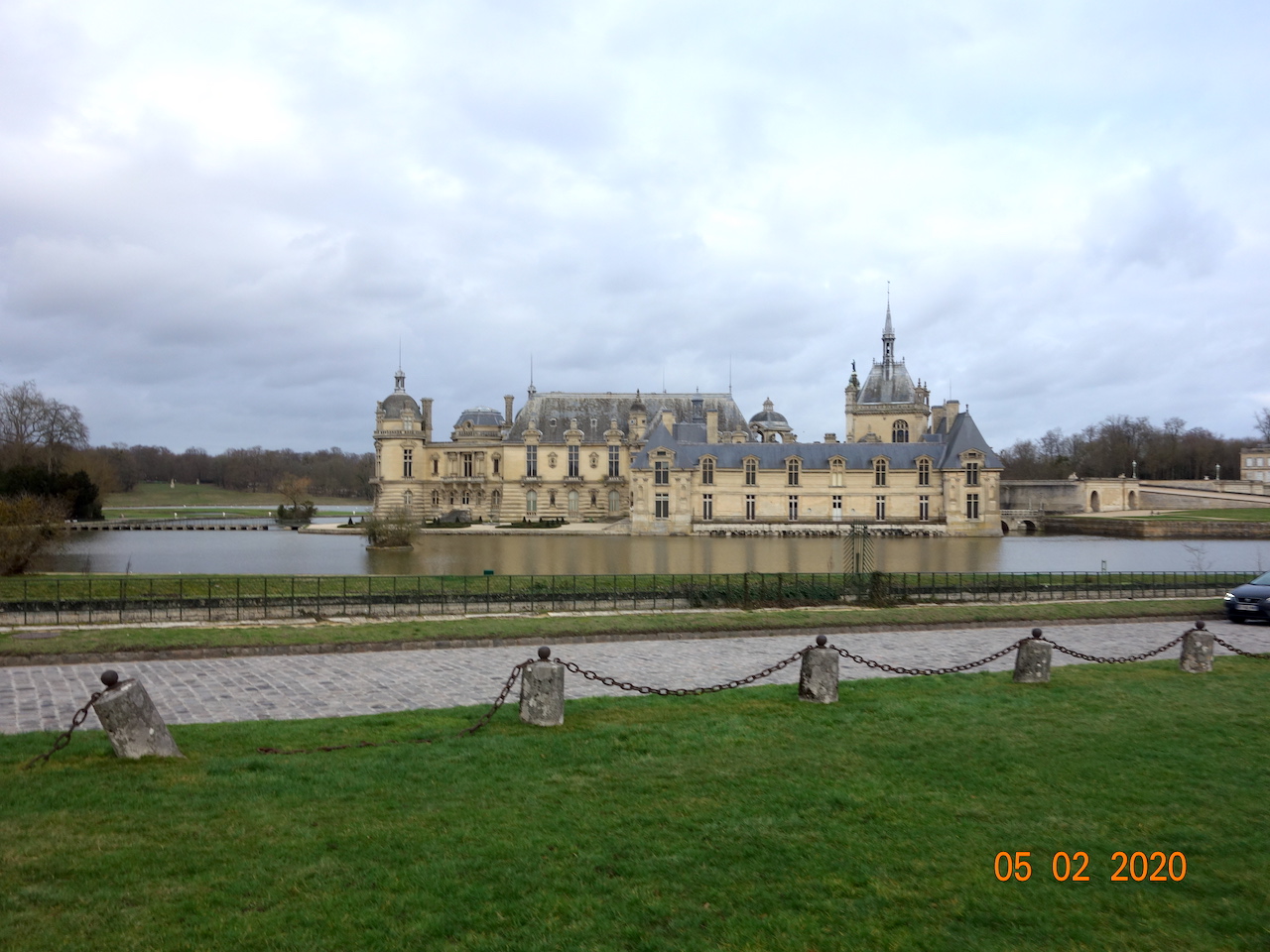
Hauts-de-France
6. Chantilly to Nanteuil-le-Haudouin
Difficult
8h
31,7km
+285m
-241m
Step
Embed this item to access it offline
A large part of your stage crosses the Oise - Pays de France Regional Natural Park with the site of the Chaalis Abbey before reaching the city where Saint Valbert, the third abbot of the Luxeuil Monastery, was born.
6 points of interest
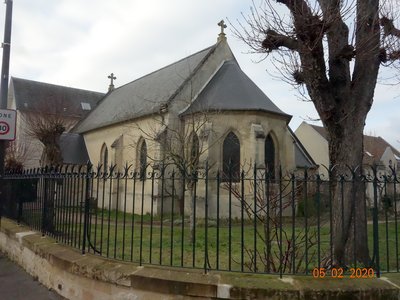
Église St-Peter à Chantilly - Association Colomban en Brie TouristThe town of Chantigny
Chantilly is known for its château, which houses the collections of the Musée Condé, and for its whipped cream. It is also internationally renowned for its horse-riding activities: in addition to its racecourse, where two prestigious horse races are held, the Jockey Club Prize and the Prix de Diane, the town and its surroundings are home to the largest racehorse training centre in France.
Intimately linked to the de Montmorency family from the 15th to the 17th century, then to the de Condé family from the 17th to the 19th century, Chantilly developed around its castle and its outbuildings. Its town planning only dates back to the 18th century. At the beginning of the 19th century, it became a small pioneering industrial centre, notably in the production of porcelain and lace, but above all a privileged place of leisure and holiday for the aristocracy and the artistic world, as well as the place of residence of an English community, linked at the time to the world of horses, at the grateful invitation of the Duke of Aumale, and still today strong with 350 families. The Anglican Church of St Peter's is worthy of note. On the rue du connétable, one will pass in front of the Spoelberch Foundation of Lovenjoul which has kept the name of the patron who had donated his library to the Fondation de France in 1905.
In the centre of the hemicycle opening onto the racecourse stands the statue of the Duke of Aumale by Jean Léon Gérôme. Henri D'Orléans Duc D'Aumale was the son of Louis Philippe and Queen Marie Amélie. He had the Château de Chantilly rebuilt to house the rich collections of the Musée Condé. He donated his possessions to the Fondation de France.
Notre-Dame de l'Assomption Church This building was commissioned by the great Condé and is the work of the architect Jules Hardouin-Mansart. The construction, completed in 1691, possesses architectural characteristics typical of the French classical architecture of the Counter-Reformation: reference to Antiquity, symmetrical composition, study of proportions, balance and sobriety of the decorations.
More information Wikipedia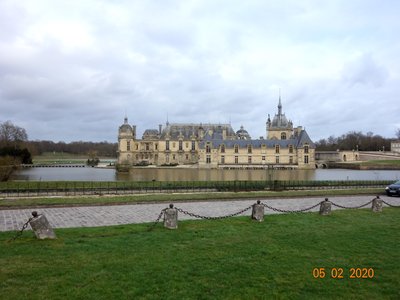
Le château de Chantilly devant le plan d’eau - Association Colomban en Brie HistoricalCastle and Racecourse in Chantilly
In the castle you can visit the Musée Condé, the second largest collection of old paintings after the Louvre, which has a magnificent collection of 800 works and is one of the most beautiful museums in France.
The large apartments allow visitors to admire the 18th century decorations of the princes.
Furniture purchased by the Duc d'Aumale, contemporary to the decorations, embellish the tour.
As part of the large apartments, the Cabinet des Livres holds 19,000 volumes, 1,500 manuscripts and 17,500 printed works, the library and archives of the château, 44,000 old books including 700 incunabula; 1,500 manuscripts including 500 illuminated ones make up a fabulous collection, including the "very rich hours of the Duke of Berry".
The small apartments of the Duc d'Aumale bear witness to the way of life of the 19th century as they remained unchanged after the death of their owner. A real journey into the intimacy of the duke.
The Grandes Écuries house the Horse Museum, and the internationally renowned racecourse is nearby.
More information Wikipedia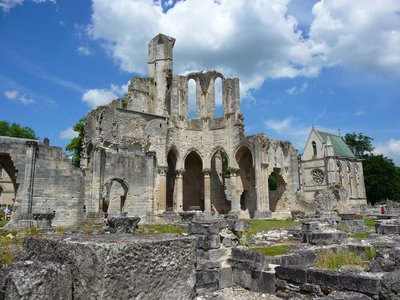
Vestiges de l’église médiévales de l’abbaye de Chaalis - oisetourisme.com HistoricalRoyal Abbey of Chaalis
Around 1100, Renaud, Lord of Mello, wishing to thank God for his safe return from the crusade, founded a priory of Benedictine monks dedicated to Saint Magdalene. He attached to it a small religious community, already established in the vicinity of Chaalis and endowed it with land. Near Senlis, the royal residence of Louis VI the Fatty (1109 - 1137). In order to strengthen the links between Church and power the king founded the Royal Abbey of Chaalis in 1137, and integrated it into the Cistercian order, which was in full expansion at that time, under the name of Caroli locus, the place of Charles, in memory of Charles the Good. It remained one of the most important religious communities of the kingdom between the 12th and 16th centuries. The order so depleted the abbey's income that in 1787 it went bankrupt. Today the ensemble belongs to the Institute of France.
In the 19th century, the site was the property of rich collectors such as the Jacquemart-André family. More than 6000 works of art are gathered (furniture, paintings, sculptures, objets d'art...). The Château, the Orangery, the Chapel, the Rose Garden and the park of the Abbey of Chaalis has become a place for events, receptions, exhibitions, seminars...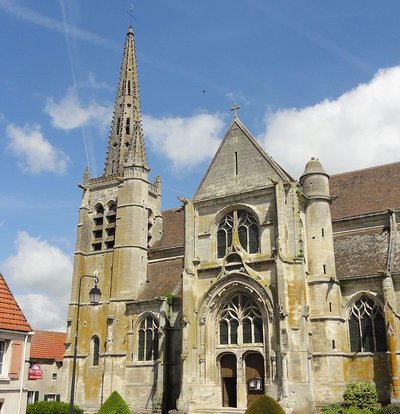
Entrée de l’église Saint-Pierre et Saint-Paul à Baron - Association Colomban en Brie TouristSaint-Pierre et Saint-Paul Church in Baron
St. Peter and Paul's is a parish Catholic church. Its bell tower with a 45 m high stone spire dates from the 15th century. The church was built entirely in the 16th century in the Flamboyant Gothic style and has a rare homogeneity, even more so inside than outside. The high walls of the nave and choir are bare above the large arcades. The interior is very sober: there is not a single capital, and the mouldings are concentrated on the corrugated piers and the large arcades, but the clear lines and harmonious proportions create an impression of elegance, underlined by the 18th century woodwork from Chaalis Abbey.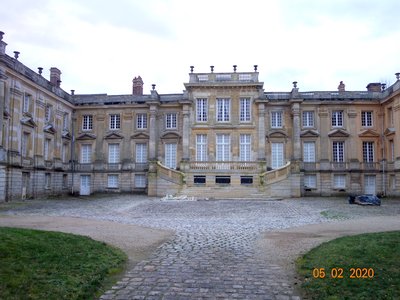
Cour d’honneur du château Versigny - Association Colomban en Brie HistoricalVersigny Castle
The Château de Versigny is located to the east of the site of the old medieval fortified castle. The present castle was built between 1640 and 1690, and the two wings on the north side, overlooking the main courtyard, are closed in the shape of a horseshoe. A first modification took place in 1770, concerning these two wings, which were partly demolished to open the courtyard to the outside. In 1835, the owner at the time, Xenaï de Junquières, had the facades of the castle refurbished to the appearance they have today, with the addition of balustrades, steps and columns. However, some cornices and belvederes were removed in 1905. The Château de Versigny has never been sold since 15 February 1401, passing from one family to another exclusively by inheritance. Since 1848, the castle has been the property of the de Kersaint family. A major renovation program has been carried out since the Second World War.
The park of the castle with its beautiful and vast French garden, which Le Nôtre designed in 1650, as well as an English garden to the east. Its surface area was about one hundred hectares. In the 20th century, the park remained abandoned for a long time. Its renovation began in the 1980s, but the major storms of 1987, 1993 and 1999 tore down many trees. In July and September, the park is open to visitors every day from 2pm to 6pm, admission is free.
Vue de l’église Saint-Martin de Versigny depuis la Via Columbani - Association Colomban en Brie TouristSaint-Martin Church in Versigny
The church of Saint-Martin de Versigny is a Catholic parish church. Its sober bell tower from the end of the 15th century carries a high and elegant openwork spire from the same period, whose style evokes the 13th century. The rest of the church dates for the most part from the second quarter of the 16th century, and is of a very neat flamboyant gothic architecture. Despite its shallow depth, the central vessel is wide and slender, and the pillars are particularly slender. A gable-sided apse follows the three straight bays, which are accompanied by aisles ending in a flat chevet. The last bay of the south aisle is decorated with tri-lobed arcatures on the outside, and a vault enriched with four secondary keys delimiting a rectangle. A blocked portal to the south and the remarkable stone altarpiece date from 1561 and are in Renaissance style. The western portal, in a late Renaissance style, was made later.
Description
In front of the church of Notre-Dame de l'Assomption in Chantilly, turn left on Route Pavée, in front of the entrance of the castle straight into the wood, during this stage you will follow the red and white markings.
- Turn right at the crossroads of the route de l'Entonnoir, cross the D138e, straight ahead with red and white markings, at the roundabout of the Poteau de l'Entonnoir, sixth road on the right, route du Chêne Pouilleux, in the axis of the route de l'Entonnoir
- Turn left at the crossroads with Chaussée Brunehaut, right with red and white signs on Route du Chêne Pouilleux, cross D1017 crossroads Saint-Jean straight ahead at all crossroads on Route du Chêne Pouilleux, pass under the Autoroute du Nord.
- Second road on the right at the Poteau de la Victoire, stay on your right at the crossroads of the monks, on the left at the crossroads of the Écureuil, red and white markings, cross route de la victoire, on the right route des Pots au Beurre
- Cross route de Borest, continue on route des Pots au Beurre, straight ahead at the crossroads, chemin des Châtaigniers, left at the second crossroads chemin de Thiers route du Litre, right at the second crossroads route du Litre straight ahead with red and white markings, cross D126, old chemin de Meaux.
- Third road on the left after D126, road on the left in front of the stables of Chaalis Abbey, at the crossroads on the right, on the right at the crossroads towards Montlognon, in front of the cement works first road on the left, cross the D 100 straight ahead, pass over the railway line
- Turn left then right at the crossroads red signposts and bench, cross D 330, straight ahead C11, then V 11 route du Cornollier, right V 11 at the water tower dirt road right, right crossroads towards Droizelles rue du Château, pass in front of the church on the right rue du Moulin
- First dirt road on the left along the castle property, straight ahead at each crossroads cross the railway, left allées des Moulins, left rue de Beauregard cross N2, continue rue de Beauregard, second street on the right at the crossroads, rue Carnot, rue Gambetta, left rue Charles Lemaire you arrive at the Saint-Pierre church in Nanteuil-le-haudouin.
- Departure : Notre-Dame de l’Assomption Church, 5-7 rue du connétable, 60 500 Chantilly
- Arrival : Saint-Pierre Church, 1 rue du Puiseau, 60440-Nanteuil-le-Haudouin
- Towns crossed : Hauts-de-France
Altimetric profile
Report a problem or an error
If you have found an error on this page or if you have noticed any problems during your hike, please report them to us here:




